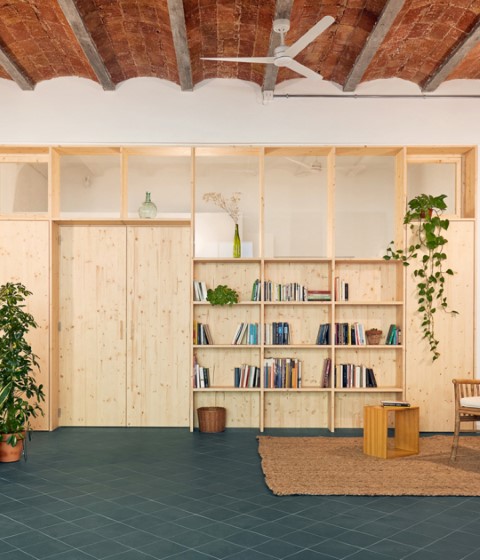While in a conventional home, the formula is governed by the addition: 1(D) + 1(ST) = 2
In MULTIPLE HOUSE, the variables are multiplied, 1(D) x 1(ST) = 1
Under this premise, the formula is repeated exponentially in the various associations of uses in MULTIPLE HOUSE: 1 (D) x 1 (ST) x 1 (AO) = 1
* AO = leisure area
The project starts from the structural perimeter as a base, thus establishing a new spatial configuration from the definition of a wet axis that includes the kitchen and bathroom, which are articulated by the access area. The program is organized through the use of a series of mobile-folding mechanisms, such as panels, beds and desks.
The dominant material is fir pine wood, which is used both in the flooring and in the furniture, thus establishing a continuous expression between all the spatial elements arranged. For the mobile partitions, polycarbonate was used, which allows the use of natural light in the areas farthest from the windows of the house.

Multiple House by P+S Estudio de Arquitectura. Photograph by Imagen Subliminal.

Multiple House by P+S Estudio de Arquitectura. Photograph by Imagen Subliminal.
Project description by P+S Estudio de Arquitectura
MULTIPLE HOUSE, responds to the commission for the renovation of a 45 m2 flat located in the historic centre of Madrid, taking up the idea that the dwelling, in mathematical terms, can function as a multiple of itself, thus seeking to multiply the possibilities of appropriation in a reduced spatial area. Specifically, this means that the house is not the result of the addition of various uses assigned to different spaces, but rather that a single space is capable of multiplying on itself and accommodating a multiplicity of uses, thus maximising its possibilities. In short:
- While in a conventional dwelling, the formula is governed by addition: 1 (B) + 1 (WA) = 2
- In MULTIPLE HOUSE, the variables are multiplied: 1 (B) x 1 (WA) = 1
* B = bedroom, WA = working area
Under this assumption, the formula is repeated exponentially in the various associations of uses in MULTIPLE HOUSE:
1 (B) x 1 (WA) x 1 (LA) = 1
* LA = leisure area
In this way, the project reconfigures the original subdivision of the dwelling, leaving only the structural perimeter as a base, thus establishing a new spatial configuration through the definition of a wet axis that brings together the kitchen and bathroom –articulated by the access area– and the use of a series of movable-foldable mechanisms (panels, bed, desk). The two main spaces are thus conceived as flexible scenarios, adaptable to the transformation of needs in everyday use, which can also lead to the appearance of new corners, visual relationships and circulations.
MULTIPLE HOUSE proposes a superposition of possibilities that offers a wide range of ways of experiencing the space, breaking the physical limitations imposed by the dwelling in its original state. This is closely related to the idea of building more indeterminate and more appropriable spaces, which opens the way to randomness, flexibility and the transformation of uses.
On the other hand, the strategy with the material consists of minimising the number of elements used, so that the material contributes to unifying the spatial operation and thereby reduce the resources used in the work. The main material is therefore defined, as spruce wood, which is used both in flooring and furniture, thus establishing a continuous expression between all the spatial elements arranged. At the same time, the use of grey microcement was chosen for the wet areas of the bathroom and kitchen to avoid joints and facilitate future maintenance. The polycarbonate used for the movable partitions seeks to define a new area to glimpse, connect, divide, and illuminate the deepest part of the house, thus establishing a subtle and economical operation for these elements.




































































